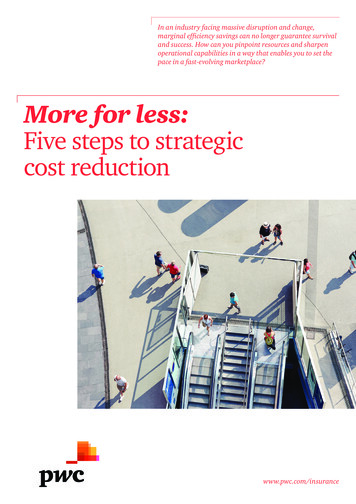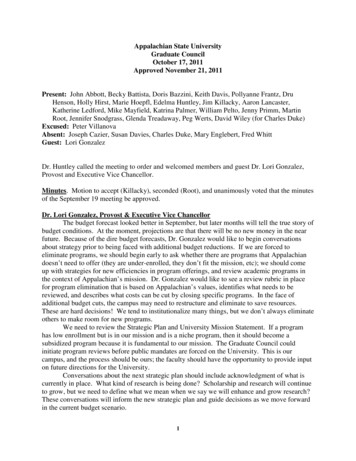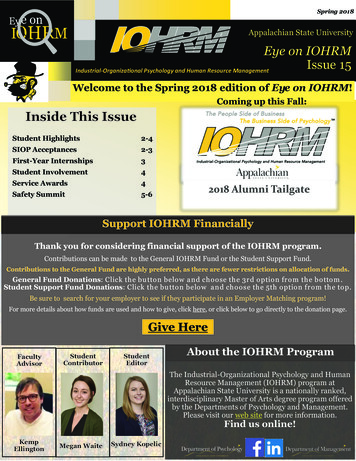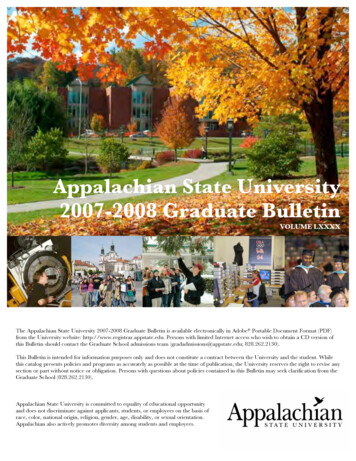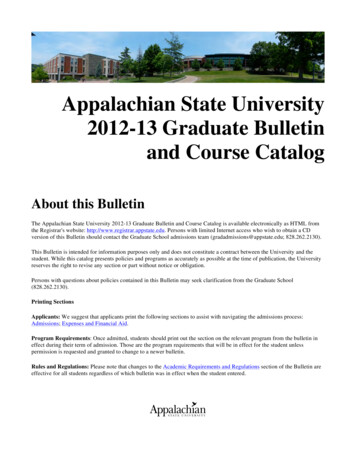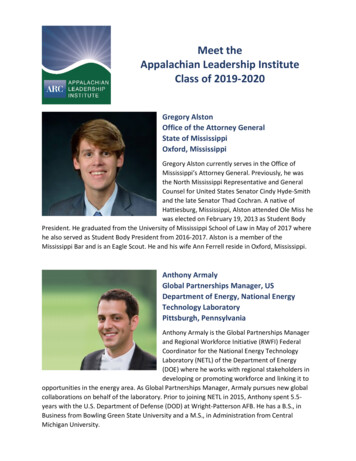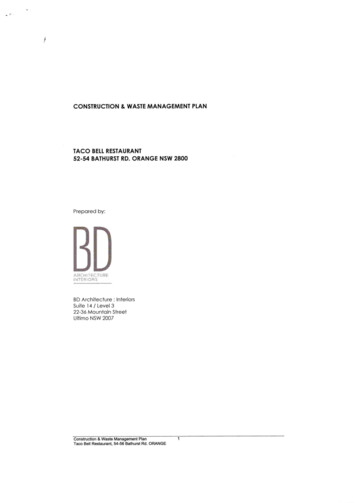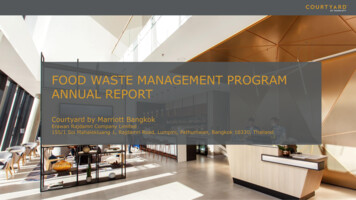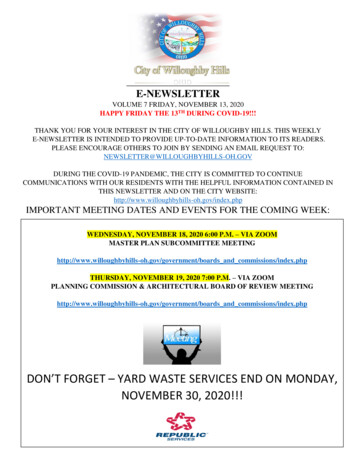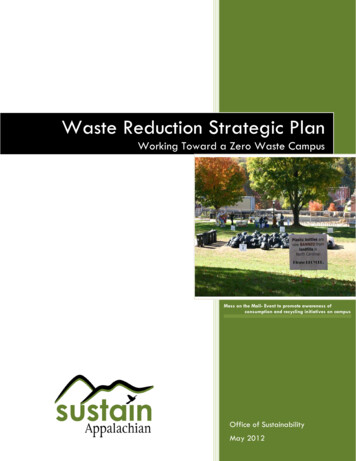
Transcription
Waste Reduction Strategic PlanWorking Toward a Zero Waste CampusMess on the Mall- Event to promote awareness ofconsumption and recycling initiatives on campusOffice of SustainabilityMay 20121
Submitted to:Submitted by:Appalachian State UniverityOffice of Sustainabilitysustain.appstate.eduDate:For furtherInformation:Jennifer Maxwell:Resource Conservation his document contains language of a technicalnature relating to the measurement of greenhousegas emissions on a college campus. A basicunderstanding of these concepts is assumed. Aglossary in Section IX provides a few brief definitions.2
Waste Reduction Strategic PlanMay 2012ContentsI. Executive Summary .5Scope of Report .5Stakeholders .6II. Introduction .7Strategic Driver of Zero Waste .7III. Current Waste Diversion Program.8Waste by the numbers .8Cost of Waste Management .10Program Successes .11Recycling Program Update and Expansion . 11Electronics Reuse and Recycling . 12Recycle at The Rock. 13Composting Program . 14Goods Exchange (Swap) Events . 15Don’t Throw It Away . 16IV. Strategic Initiatives .17Initiative #1- Conduct a Comprehensive Waste Audit .17Key Actions . 17Key Indicators . 17Initiative #2- Expand Reuse and Recycling Efforts .18Key Actions . 18Key Indicators . 18Initiative #3- Expand Composting Efforts .18Key Actions . 18Key Indicators . 19Initiative #4- Institute an Environmentally Preferable Purchasing Program .19Key Actions . 19Key Indicators . 20Initiative #5- Encourage Campus Engagement .20Key Actions . 20Key Indicators . 20V. The Role of Education and Engagement .203
Other University Examples of Engagement .21VI. Challenges and Opportunities .21University Commitments . 21Financial Commitments . 22Transparent Data Reporting . 22VII. Path to Zero Waste .23Where to Go from Here.23Now 2012-2014. 23The foreseeable tomorrow 2015-2018 . 25On-going efforts towards a sustainable future . 25Path to Zero Waste- A Timeline .27VIII. Definitions .28IX. Resources and Further Reading .30Appendix A .314
I. Executive SummaryScope of ReportAppalachian State University is committed to becoming a zero waste campus through a goal of 90%diversion by 2022. Using zero waste as a guiding principle, this diversion rate can be restated as a 90%diversion of municipal solid waste (MSW) from the landfill. Over the next 10 years, Appalachian willwork toward zero waste through several initiatives outlined in the following strategic plan. Zero waste,for the purpose of this document, seeks to rethink the way resources and materials flow through theuniversity by taking a whole system approach. This approach will strive to reduce overall consumption,return material goods for reuse, compost all applicable organic matter to promote new growth, andthen recycle goods and materials at the end of their usage lifespan.Reducing the university’s consumption is crucial to begin any creation of a sustainable waste cycle. IfAppalachian can begin to eliminate waste in the first place, the university is on the proper path toward azero waste campus. Reduce being the most important of the 3 R’s: reduce, reuse, recycle, it is criticalthat the university begins to embrace waste reduction, and considers this commitment in all decisionsmade.The Waste Reduction Strategic Plan proposes the framework for achieving the ambitious zero wastegoal directed by The University of North Carolina (UNC) System Sustainability- UNC Policy Manual600.6.1. Overall, the university’s execution of these goals will need to be consistent with the mission ofthe university and deemed to be cost effective. Specific initiatives have been identified for achievingsuccess throughout the 10 year process. Each initiative also has indicators to gauge progress andprovide guidance for future action plans or program expansion. This document is meant to be flexibleand reviewed on a periodic basis as resources, technology and opportunities evolve on the AppalachianState University campus.To achieve zero waste will require dedication. The campus community must view this as an educationalopportunity where we are simultaneously teaching and learning from one another. The complete set ofanswers to this complex problem is not known and can only be found through an interconnected andcollaborative effort. This will challenge everyone to rethink their usual habits in accordance with aneffort that is based on a respect for the importance of sustainability, the commitment to zero waste,and each other. Administration, faculty, staff, and students must be prepared to both lead by exampleand to be respectful users of our campus infrastructure, with zero waste being the critical driver.For strategic planning purposes, the next 10 years has been divided into temporal periods as describedbelow:PeriodDescriptionFoci.2012-2014The NowAwareness, Operational and Organizational Readiness2015-2018The Foreseeable TomorrowInfrastructure Upgrades, Cultural/Behavioral Shift2019-2022The Sustainable FutureTransformation, Paradigm ShiftWorking toward zero waste is important to the university because consumption and waste managementpractices have a major impact on the health of the planet, as well as its people. Appalachian StateUniversity handles over 3200 tons of waste annually whether through reuse, recycling, composting, or5
landfilling. Changing consumption behaviors and purchasing habits to reduce this tonnage, and recoverwaste as a resource through sustainable management habits is the responsible thing to do whenconsidering limited natural resources, expanding population growth, and economic potential. Inaddition, it assists with the education of the campus community around responsible purchasing habits,consumption behaviors, and responsible living for a sustainable future.StakeholdersThe Office of Sustainability (OS), in conjunction with campus services, has led in the coordination andcreation of this planning document. Many elements of the university have played significant roles in itspreparation. These groups include: university administrators, faculty members, staff members, andstudents. Also engaged in this process will be the University Sustainability Council, which was foundedin 2008. A Purchasing and Waste Subcommittee has been created that will manage and track theprogress of the movement towards zero waste.Listed below are some of the many persons who will play a part in this effort:Dr. Kenneth PeacockGreg LovinsCarol AcquestaJim BryanDebbie CarriereTodd CherryGerald CombsJake CoxTom Van GuilderDr. Tom KaneArt KesslerJennifer MaxwellLindsay MillerGed MoodySeth NorrisMike O’ConnorDwayne OdvodyKarl “Casey” PondDave RobertsonCrystal SimmonsJeff TalbotDr. Greg TaylorLinda TothChancellorVice Chancellor Business AffairsDirector of Planning, Design, and ConstructionLandscape Services SuperintendentBuilding Services ManagerEconomics Faculty, Purchasing and Waste SubcommitteeRecycling Operations ManagerSGA Director of International and Environmental Affairs, Purchasing and WasteSubcommitteeDirector of Technology Support Services, Purchasing and Waste SubcommitteeUniversity Housing DirectorFood Services ManagerResource Conservation Specialist, Purchasing and Waste SubcommitteeSustainability SupportUniversity Sustainability DirectorDirector of Environmental Health Safety & Emergency Management, Purchasingand Waste SubcommitteePhysical Plant DirectorDirector of Materials Management, Purchasing and Waste SubcommitteeMBA Student, Sustainable Business, Class of 2011Director of Student Programs and the Plemmons Student Union, Purchasing andWaste SubcommitteeSustainability SpecialistPurchasing Manager, Physical PlantDirector of Campus Services Division, Purchasing and Waste SubcommitteeSustainability Graduate Assistant, Class of 20136
II. IntroductionStrategic Driver of Zero WasteAppalachian’s Sustainability Mission, Vision, and Values are in direct support of the zero waste initiative.This section features the text of this statement adopted in 2010.Sustainability Mission StatementAppalachian State University leads in creating a world where environmental, societal, and economicqualities exist in balance to meet the resource needs of today and of future generations. Ourcommunity of students, faculty and staff continually advance our understanding, capabilities andpractices in this vital journey. As an institution of higher learning, we lead by example, inspiring newgenerations prepared to share this knowledge, ingenuity and passion.Our Sustainability Vision Engage faculty, students and staff in ongoing dialogue, inquiry, and discovery of moresustainable practices through curriculum, degree programs, and scholarly research. Empower students across the curriculum with awareness in sustainability issues and a capacityto contribute to the construction of sustainable societies. Integrate sustainable practices into all aspects of university planning and operations, focusingboth on the current and future implications. Design, build and operate a campus environment that minimizes its ecological footprint,contributing to the goal of climate neutrality. Create new paradigms for energy, transportation, water, waste and food systems thatcontribute to best practices in higher education. Participate in research initiatives and outreach activities that educate our communities, nourishour natural ecosystems, and enrich our cultural experiences. Embrace health, diversity, tolerance, and human rights as principles by which policy and processare designed.Sustainability Essential CharacterAppalachian has a decades-long commitment to sustainability, offering multiple degree programsand engaging our community through innovative initiatives. We honor this history and boldlymove forward, inspired by our unique mountain setting and with a genuine respect for the naturalenvironment. We recognize that sustainability is a journey, and “sustain Appalachian” is ourcommitment to advance our knowledge, to demonstrate innovative practices, and to lead byexample.Core Sustainability Values Focused on our roles as educators and researchers, instilling the knowledge and values ofsustainability into our entire community. Understand that decisions throughout the university have sustainability implications which mustbe considered and addressed. Realize that sustainability must focus on interrelated environmental, societal, and economicissues and resources at both the local and global levels.7
Open to continually educate ourselves on the principles and possibilities of sustainability andwilling to pursue innovative solutions.Committed to transparent reporting of our sustainability goals, initiatives and progress to theAppalachian community and beyond.Respect the planet's natural environment and our unique mountain setting, embracing ourinterconnectedness with these ecosystems.III. Current Waste Diversion ProgramMany of the steps and initiatives required and associated with zero waste are already underway onAppalachian’s campus. Appalachian State University has made great strides in achieving a 40% diversionrate through the work of the Waste Reduction and Recycling program. As part of a commitment to zerowaste, the goal of this document is to enhance partnerships with the campus community to promotesustainable resource management practices and to conserve the planet’s natural resources. Appalachianintends to promote a steady increase in the overall waste diversion rate while further educating thecampus community and public on zero waste initiatives.Waste by the numbersThe graphs below depict in greater detail what Appalachian has reported for the last five years in termsof the diversion rates and quantities for various waste stream classifications. It is from these baselinepositions that Appalachian will develop more robust dialogue around strategies to reach a zero wastegoal.Reuse/Recycling vs. 607FY0708FY0809Reuse/Recycling 447.31771.6901.48 1219.31 1228.37Landfilled21542099.1 1822.69 1975.672126FY0910FY1011Graph 3.1As outlined in Graph 3.1, there has been a steady increase in the amount of waste captured for reuseand recycling. Over the past six years, the university has been able to divert more materials from thelandfill. Through program expansion and development, Appalachian has been able to increase thetonnages of reuse/recycling.8
As evident in Graph 3.1, there is still an increase in the tonnage of waste generated overall. Populationgrowth can contribute to some of this growth, but with careful consideration of the waste stream, thetotal waste generated can be reduced.% Diverted through Reuse andRecyclingWaste Diversion %26%30%40%38%Graph 3.2As outlined in Graph 3.2, Appalachian has been able to increase the waste diversion rate from 17% in FY2007 to 40% in FY 2010. This growth can be attributed to program updates, new program development,better tracking, and program successes. In FY 2011, there was a decrease in the diversion rate by 2%.This is due to the fact that food waste collection for composting had to be put on hold during theconstruction of our new state of the art compost facility. The university was unable to obtain permittingat an alternate location while construction of new facility took place, so all organics had to be landfilledduring this period.9
Cost of Waste ManagementThe handling of municipal solid waste (MSW) at Appalachian State University is very expensive. In FY2011, it costs the university approximately 1.2 million dollars to manage and dispose of the MSWgenerated on campus. As depicted in graph 3.3, these costs include labor, haul and tip fees, equipment,maintenance, and fuel charges for the management of both trash and recycling combined.Waste Management ExpensesEquipment, 41,345.62Maintenance, 24,385.04 Fuel, 16,879.59Haul/Tip Fees, 148,519.80Labor, 960,992.28Graph 3.3Recycling does provide some avoided costs due to the tipping fee associated with MSW being hauled tothe landfill. It costs us 49/ton tipping fee to dispose of trash, while there is no tipping fee for recyclingdisposal. In FY2011, Appalachian spent over 96,800 in tipping fees alone for our MSW.Recycling also has the potential to generate a revenue stream. In FY 2011,
Appalachian State University is committed to becoming a zero waste campus through a goal of 90% diversion by 2022. Using zero waste as a guiding principle, this diversion rate can be restated as a 90% diversion of municipal solid waste (MSW) from the landfill.
